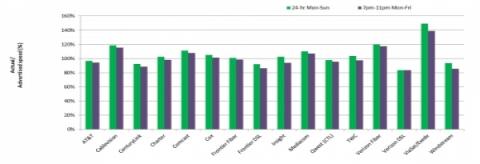Updated study shows providers on average delivered 101% of advertised downstream speed.
Most customers who pay for broadband Internet connections over cable, DSL, fiber-optic and satellite networks are getting what they’re paying for, an updated FCC study shows.
The FCC’s Measuring Broadband America report, released June 18 and based on 8 million measurements involving 177 million unique tests, found a close alignment between advertised broadband speeds and the actual performance providers are delivering.
The report found that on average, the 16 measured broadband providers delivered 101% of advertised downstream speeds, and 107% of advertised upstream speeds.
Performance varied by provider, however. Of the 16 broadband providers evaluated during September 2013, 10 matched or exceeded the download speeds advertised for particular service offerings over a full-time, 24x7 measurement span. During high-demand hours of 7-11 p.m. Monday through Friday, performance lagged to a greater degree, with 10 of the 16 providers falling short of advertised downstream speeds. (The 10 peak-time laggards: AT&T, CenturyLink, Charter Communications, Frontier Fiber, Frontier DSL, Insight, Qwest, Time Warner Cable, Verizon DSL and Windstream.)
The largest performance gap came from Verizon’s DSL service, which managed only 83% of advertised rates during both time intervals. Comcast, the nation’s largest broadband provider, clocked in at 111% of advertised speeds on a 24/7 basis, and 107% during peak hours.

Satellite supremacy (sort of)
Repeating for the second year as best-in-class from a performance versus advertising standpoint was ViaSat Inc.’s Exede satellite broadband service, which blew past its advertised downstream speeds. On an around-the-clock basis, ViaSat delivered 150% of its advertised downstream speed of 12 Mbps, and during peak hours, the satellite provider registered 139% of the advertised data rate. (The downside: each of Exede’s three broadband plans involve caps on the amount of data customers can use each month before paying a surcharge, and owing to the long distances packets must travel to get to and from its satellite, Exede’s average latency of 671 milliseconds is 19x the FCC-measured average for other broadband providers. Sorry, gamers.)
Drilling down beyond averages, however, the FCC found ISPs have room to improve in terms of service consistency. The FCC found about one-third of the ISPs delivered only 60 percent or better of advertised speeds 80 percent of the time to 80 percent of their consumers. “This is a metric that we expect ISPs to improve upon over the course of the next year,” the commission report said.
